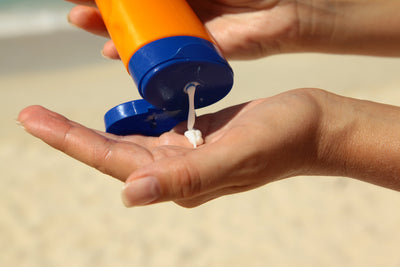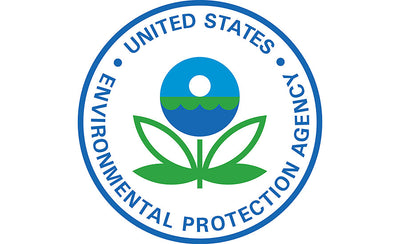Water Quality InformationWritten By Actual Experts
RSSHealth Effects Caused by Exposure to PFAS Chemicals

Oxybenzone and Drinking Water

Emily Driehaus | Science Communication Intern
Oxybenzone is a common sunscreen ingredient that has been shown to have negative impacts on human health and the environment. Evidence has shown that it can contaminate drinking water after being washed down the drain while showering off sunscreen.
What is Oxybenzone?
Oxybenzone is a UV filter used in sunscreen and other cosmetics. It absorbs UV rays from the sun and helps prevent them from penetrating the skin and causing sun damage. While it does help protect our skin against the sun, it has implications for both our health and the environment, particularly aquatic life.
Oxybenzone and Marine Life
Much of the concern regarding oxybenzone began when researchers noticed damage to coral reefs near beaches with many visitors. As sunscreen gets sloughed off the skin by the water and sand, it can make its way into the ocean and harm aquatic life. Coral reefs are especially susceptible to damage, as oxybenzone can harm normal growth and development, damage DNA and put them at an increased risk of bleaching.
Health Implications of Oxybenzone
As research into oxybenzone has continued, it has been designated as an endocrine disruptor. Endocrine disruptors interfere with normal hormonal processes in the body and can impact the reproductive system. Most research on oxybenzone in the human body has focused on absorption through the skin rather than ingestion, but more evidence has shown that oxybenzone is present in drinking water, especially in communities near large bodies of water.
How Does Oxybenzone Get Into Drinking Water?
After a day at the beach, most individuals hop in the shower to rinse off the sunscreen and sand that has accumulated on their skin throughout the day. When this water goes down the drain, it goes to wastewater treatment plants to be treated before being released into water sources, which can be used for drinking water. Wastewater treatment plants and drinking water facilities lack the ability to filter out endocrine disruptors like oxybenzone, so it ends up in drinking water consumed by the public. A study looking at oxybenzone in Honolulu tap water showed that individuals consume between 0.8-1.2 micrograms of oxybenzone a day from drinking water. This concentration is not particularly harmful to fully grown adults, but can have a greater impact on children, infants and developing fetuses.
Regulations on Oxybenzone
The previously mentioned study was submitted as part of testimony on a bill that would ban the sale of sunscreens containing oxybenzone in the state of Hawaii. The bill passed in 2018 and went into effect at the beginning of this year. The city of Key West, Florida has also enacted a ban on sunscreens with oxybenzone in an effort to protect coral reefs. These bans are not without controversy, as skin damage from UV rays can lead to skin cancer and banning sunscreens with oxybenzone leaves individuals in these areas with one less form of sun protection.
What Should I Do if I’m Concerned About Oxybenzone in my Water?
Carbon water filters are able to filter out oxybenzone and other endocrine disruptors. Using sunscreen with ingredients like zinc oxide or titanium dioxide rather than oxybenzone can also reduce your overall exposure. Switching sunscreens will also help protect aquatic life when you swim in bodies of water like lakes or oceans.
Other Articles We Think You Might Enjoy:BPA and Phthalates: Are These Two Endocrine Disruptors in Your Water?
Trump's "Dirty Water Rule" to be Revised
Drinking Water Supplies Risk Contamination from Toxic Wastewater Ponds
PFAS Water Filters for Easton, Massachusetts

Analies Dyjak, M.A. | Head of Policy
Recent testing requirements in the State of Massachusetts have forced local governments to take a closer look at the safety of their drinking water. These new requirements have revealed that Easton, Massachusetts, has elevated levels of PFAS in their tap water. This article will address what PFAS compounds are, the levels in Easton drinking water, and water filtration brands that actually remove them.
PFAS in Easton, Massachusetts
The City of Easton, Massachusetts recently reported that PFAS are present in the city’s drinking water supply. State-level regulations of PFAS chemicals are relatively new, particularly in Massachusetts. Municipal water supplies were not required to even test for PFAS compounds until January 2021, when the state implemented these requirements. Up until that point, people in Easton and many other municipalities in Massachusetts did not know they were being exposed to this potentially cancer-causing chemical.
In October, 2020, the Massachusetts Department of Environmental Protection set an enforceable standard of 20 parts per trillion for the sum of six PFAS compounds in drinking water. The six compounds, called PFAS6, are: PFOS, PFOA, PFHxS, PFNA, PFHpA, and PFDA. This regulation means that if a water sample exceeds 20 parts per trillion for all six compounds, that the municipal provider is in violation of the state law. The table below shows elevated levels of PFAS in Easton source water. A more detailed and thorough analysis of these results can be found on the Easton, MA, website dedicated to PFAS testing.

What Are Per and Polyfluoroalkyl Substances?
Per and Polyfluoroalkyl Substances (PFAS) are a category of harmful compounds that can be found in drinking water sources across the country. PFAS can take hundreds of years to degrade in the environment which is why you may see them referred to as ‘forever chemicals.’ PFAS are not currently regulated at the federal level, but some states have created regulations or monitoring criteria, including Massachusetts. They are known to increase the risk of cancer, increase cholesterol, increase the risk of miscarriage by 80-120%, and several other negative health outcomes. According to the National Institute of Health, over 4,700 different PFAS variations have been used in some type of manufacturing since the 1950’s.
Is 20 ppt Safe?
There’s a bit of uncertainty around the “safe level” of exposure to PFAS compounds. There are only a handful of studies that assess associated health impacts, and most agree that more research is necessary to make a determination. In 2016, EPA set a non-enforceable Health Advisory Level of 70 parts per trillion for combined PFOA and PFOS. More recent data suggests that this level is far to high to provide meaningful protection against a range of negative health impacts. A recent study also found that a “safe level” or PFAS could be as low as 0.1 parts per trillion. Although the Massachusetts PFAS standard is on the lower end of state limits, our team would rather see even less PFAS allowed in municipal tap water.
Not All Water Filters Remove PFAS
If you live in Easton and you’re looking for a solution, it’s important to understand that not all water filters are able to remove PFAS chemicals. Duke University completed a study in 2020 that tested various filtration brands and their ability to remove PFAS from drinking water. The results found that popular brands including Brita and Pur did not do a good job of removing PFAS compounds. Refrigerator filters tested by the Duke research team, including; Samsung, Whirlpool, and GE, also failed to remove PFAS. The full results of this study can be found here. Hydroviv filters are both NSF certified and third-party tested to remove PFAS chemicals. To request our full testing and removal data, please email hello@hydroviv.com.
Other Articles We Think You Might Enjoy:Yale: PFAS Increase The Risk of Miscarriage by 80-120%
PFAS Update: Spring 2021
Why Do Military Bases Have High Levels of PFAS Chemicals?
North Carolina's Drinking Water Crisis

Military Bases Have High Concentrations of PFAS Chemicals

***Updated 8/29/18 to include video***
Analies Dyjak | Policy Nerd
Per and Polyfluoroalkyl Substances (PFAS) have been receiving a ton of media attention throughout this past year. PFAS are a category of toxic contaminants that have invaded public and private drinking water systems across the entire country. Military bases are extremely susceptible to this type of contamination because of necessary on-base activities. If you would like to learn more about what PFAS are, their health effects, and if they're regulated, please click here.
Why Do Military Bases Have High Concentrations of Per and Polyfluoroalkyl Substances (PFAS)?
Military bases have historically had issues with pollution, due to the nature of on-base activities. Municipal fire departments also travel to nearby military bases because they provide an open, secure area to train. So not only are military personnel being directly exposed to PFAS chemicals in water, but so are local fire departments. The Department of Defence isn’t necessarily to blame for the high rates of contamination of PFAS on military bases. The Manufacturers of PFAS-containing fire fighting foam who actively sell to the DOD are greatly at fault. Because there is no effective alternative on the market, the military has no choice but to continue purchasing and using these products. Unlike many other countries, the United States doesn’t use the precautionary principle in chemical manufacturing. This means that chemicals are introduced to the market before toxicological due diligence is completed. Most of the time it takes someone getting extremely sick for manufacturers to even begin to pay attention.
More often than not, military bases have their own underground private wells that provide drinking water to families living on base, rather than being apart of a public drinking water system. Fire fighting foam can either directly percolate into soil, or run off into surrounding surface water sources. Water from contaminated soil naturally recharges on-base drinking water wells, which families consume on a daily basis.
What Is The Department of Defense Doing About Per and Polyfluoroalkyl Substances (PFAS) on Military Bases?
The most recent data provided by the DOD stated that 99% people receiving non-DOD-treated water were served by systems with no violations, whereas only 89% of people receiving DOD-treated water were served by systems with no violations. It’s important to note that these data are from bases that voluntarily tested for PFAS chemicals in water, but they do however reiterate that military bases have higher concentrations of this contaminant than other areas in the country. In October of 2017, the US Government Accountability Office reported that the Department of Defense has taken action on PFAS. DOD has directly shut down wells or provided filtration to 11 military installations. This is definitely a step in the right direction, but there are over 400 military bases in the United States that are still contaminated. Approximately 3 million people in the US drink water provided by the DOD. Not only are active military personnel at risk, husbands, wives and children are being adversely impacted by PFAS chemicals in water. Again, manufacturers of these dangerous chemicals are mostly to blame for such high concentrations of PFAS contamination on military bases.
What Are Public Officials Doing About Per and Polyfluoroalkyl Substances (PFAS)?
EPA set a Lifetime Health Advisory Level of 70 parts per trillion for both PFOA and PFOS. The rule of thumb for PFAS is that the sum of the category of contaminants should be no higher than 70 parts per trillion. ATSDR believes this level should be reduced to 20 parts per trillion for drinking water. Again, Lifetime Health Advisory Levels and Minimum Risk Levels are non-enforceable limits that municipalities are not required to follow. DOD has not developed their own standard for PFAS in drinking water and therefore follow the non-enforceable national level of 70 parts per trillion. DOD is not at all incentivized to create a standard or even test for PFAS, because of the outrageous mitigation expenses.
Other Articles We Think You Might Enjoy:PFAS: What You Need To Know
Recap of EPA's 2018 PFAS National Leadership Summit
PFAS: Toxicological Profile






